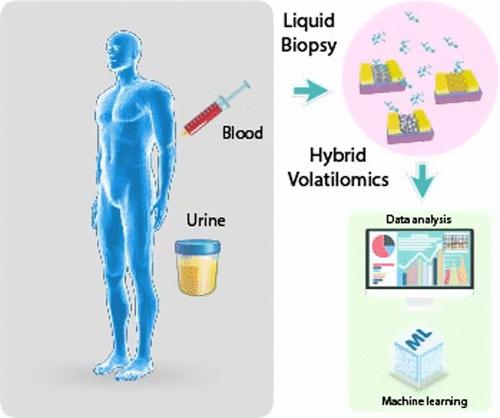Our official English website, www.x-mol.net, welcomes your feedback! (Note: you will need to create a separate account there.)
Liquid Biopsy-Based Volatile Organic Compounds from Blood and Urine and Their Combined Data Sets for Highly Accurate Detection of Cancer
ACS Sensors ( IF 8.9 ) Pub Date : 2023-03-16 , DOI: 10.1021/acssensors.2c02422 Reef Einoch Amor 1 , Jeremy Levy 2 , Yoav Y Broza 1 , Reinis Vangravs 3, 4 , Shelley Rapoport 1 , Min Zhang 5 , Weiwei Wu 6 , Marcis Leja 3, 4 , Joachim A Behar 2 , Hossam Haick 1
ACS Sensors ( IF 8.9 ) Pub Date : 2023-03-16 , DOI: 10.1021/acssensors.2c02422 Reef Einoch Amor 1 , Jeremy Levy 2 , Yoav Y Broza 1 , Reinis Vangravs 3, 4 , Shelley Rapoport 1 , Min Zhang 5 , Weiwei Wu 6 , Marcis Leja 3, 4 , Joachim A Behar 2 , Hossam Haick 1
Affiliation

|
Liquid biopsy is seen as a prospective tool for cancer screening and tracking. However, the difficulty lies in effectively sieving, isolating, and overseeing cancer biomarkers from the backdrop of multiple disrupting cells and substances. The current study reports on the ability to perform liquid biopsy without the need to physically filter and/or isolate the cancer cells per se. This has been achieved through the detection and classification of volatile organic compounds (VOCs) emitted from the cancer cells found in the headspace of blood or urine samples or a combined data set of both. Spectrometric analysis shows that blood and urine contain complementary or overlapping VOC information on kidney cancer, gastric cancer, lung cancer, and fibrogastroscopy subjects. Based on this information, a nanomaterial-based chemical sensor array in conjugation with machine learning as well as data fusion of the signals achieved was carried out on various body fluids to assess the VOC profiles of cancer. The detection of VOC patterns by either Gas Chromatography−Mass Spectrometry (GC−MS) analysis or our sensor array achieved >90% accuracy, >80% sensitivity, and >80% specificity in different binary classification tasks. The hybrid approach, namely, analyzing the VOC datasets of blood and urine together, contributes an additional discrimination ability to the improvement (>3%) of the model’s accuracy. The contribution of the hybrid approach for an additional discrimination ability to the improvement of the model’s accuracy is examined and reported.
中文翻译:

血液和尿液中基于液体活检的挥发性有机化合物及其组合数据集,用于高度准确地检测癌症
液体活检被视为癌症筛查和追踪的前瞻性工具。然而,困难在于如何在多种干扰细胞和物质的背景下有效地筛选、分离和监督癌症生物标志物。目前的研究报告了无需物理过滤和/或分离癌细胞本身即可进行液体活检的能力。这是通过检测和分类从血液或尿液样本或两者的组合数据集中发现的癌细胞释放的挥发性有机化合物 (VOC) 来实现的。光谱分析表明,血液和尿液中含有与肾癌、胃癌、肺癌和纤维胃镜检查对象互补或重叠的 VOC 信息。根据这些信息,基于纳米材料的化学传感器阵列与机器学习以及所获得信号的数据融合相结合,对各种体液进行了评估,以评估癌症的 VOC 概况。通过气相色谱-质谱 (GC-MS) 分析或我们的传感器阵列检测 VOC 模式,在不同的二元分类任务中实现了 >90% 的准确度、>80% 的灵敏度和 >80% 的特异性。混合方法,即同时分析血液和尿液的 VOC 数据集,有助于提高模型准确性 (>3%) 的额外辨别能力。研究并报告了混合方法对提高模型准确性的附加辨别能力的贡献。
更新日期:2023-03-16
中文翻译:

血液和尿液中基于液体活检的挥发性有机化合物及其组合数据集,用于高度准确地检测癌症
液体活检被视为癌症筛查和追踪的前瞻性工具。然而,困难在于如何在多种干扰细胞和物质的背景下有效地筛选、分离和监督癌症生物标志物。目前的研究报告了无需物理过滤和/或分离癌细胞本身即可进行液体活检的能力。这是通过检测和分类从血液或尿液样本或两者的组合数据集中发现的癌细胞释放的挥发性有机化合物 (VOC) 来实现的。光谱分析表明,血液和尿液中含有与肾癌、胃癌、肺癌和纤维胃镜检查对象互补或重叠的 VOC 信息。根据这些信息,基于纳米材料的化学传感器阵列与机器学习以及所获得信号的数据融合相结合,对各种体液进行了评估,以评估癌症的 VOC 概况。通过气相色谱-质谱 (GC-MS) 分析或我们的传感器阵列检测 VOC 模式,在不同的二元分类任务中实现了 >90% 的准确度、>80% 的灵敏度和 >80% 的特异性。混合方法,即同时分析血液和尿液的 VOC 数据集,有助于提高模型准确性 (>3%) 的额外辨别能力。研究并报告了混合方法对提高模型准确性的附加辨别能力的贡献。



























 京公网安备 11010802027423号
京公网安备 11010802027423号